Home | Tours | Trip Reports | News | Team | Calendar | Links | Contact | Store | Mailing List
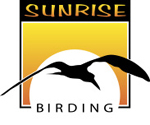
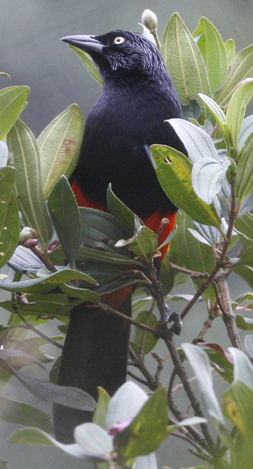 COLOMBIA
COLOMBIAOpen for Birding!
Fam Trip Report
February 20 - 28, 2009
by Gina Nichol
The avian riches of Colombia are legendary with at least 1870 on its bird list. Colombia has more species than any other country in the world and boasts 73 endemics and 21 species new to science discovered since the landmark field guide was published in 1986. The birding opportunities here are unsurpassed but until now Colombia has been inaccessible to most birders. Security concerns have kept Colombia closed to tourism and birding for decades. Efforts by the government and the military to address safety problems however, have much improved the situation and much of Colombia is now calm and safe. Tourists are returning to this clean, modern, flourishing country. Colombia is now open for birding!
In early 2009, I was invited by the government of Colombia Ministry of Trade, Industry and Tourism to participate in DESTINATION COLOMBIA, a familiarization (FAM) trip and business forum about promoting tourism in the country. My involvement had to do with the portion of the program that focused on bird watching and developing the infrastructure to support birding tours. The fam trip illustrated a few of the many possibilities in Colombia and I was pleased to have the opportunity to participate with this select group which included several guides from prominent birding tour companies and a writer from one of the birding magazines. Below is a recap of the highlights of the trip.
7-day Birding Tour: 324 species recorded
| ENDEMICS: | OTHER HIGHLIGHTS: |
|
|
21 February:
We were up early in the morning enjoying breakfast on an open terrace overlooking a garden where a few feeders were set up. We got our first views of the common Black-billed Thrush, Ruddy Ground Dove, Acorn Woodpecker (a race with a dark eye), Blue-gray and Palm Tanager, Great Kiskadee, and a female Thick-billed Euphonia. We met our local guides Sergio and Daniel and were soon off to the airport to fly to the Pacific Coast. At airport, with our faces pressed against the window, we picked up Saffron Finch, Hepatic and Summer Tanagerand as soon as we arrived in Bahia Solano we were out on the tarmac birding. Overhead were a number of White-collared Swifts and over a ridge in the distance were three Swallow-tailed Kites. Other birds here included Lemon-rumped Tanager, Black-cheeked Woodpecker and Chestnut-headed Oropendola.
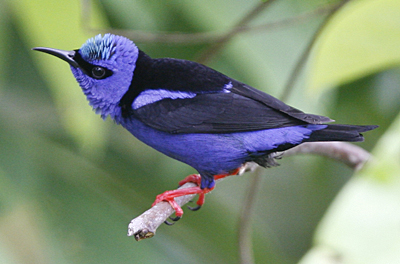 Once our arrival was processed, we boarded our transport, a typical Colombian open-air brightly colored truck called a Chiva which took us over a very rough road to our lodge on the coast. No sooner did we get going than the road was blocked by a truck that was stuck in the mud. Not to worry, while the truck was being tended to, we birded along the road and found King Vulture, Blue Ground-Dove, Bay-headed Tanager, Stripe-billed (Collared Aracari), Red-lored and Blue-headed Parrots flying over, Black-crowned Tityra, Rose-faced Parrot, and Blue-chested Hummingbird. After 8 kilometers, the road became a nice paved road and after we reached town we drove out onto a sandy beach to get to our lodge. The setting was wonderful--a beach side eco lodge with the sound of crashing waves in the background. The lodge was rustic but comfortable and its location provided access to the humid tropical forest. Our first Red-legged Honeycreeper, the species used in the lodge logo, appeared at some fruit feeders and we enjoyed many views of this little beauty during our stay.
Once our arrival was processed, we boarded our transport, a typical Colombian open-air brightly colored truck called a Chiva which took us over a very rough road to our lodge on the coast. No sooner did we get going than the road was blocked by a truck that was stuck in the mud. Not to worry, while the truck was being tended to, we birded along the road and found King Vulture, Blue Ground-Dove, Bay-headed Tanager, Stripe-billed (Collared Aracari), Red-lored and Blue-headed Parrots flying over, Black-crowned Tityra, Rose-faced Parrot, and Blue-chested Hummingbird. After 8 kilometers, the road became a nice paved road and after we reached town we drove out onto a sandy beach to get to our lodge. The setting was wonderful--a beach side eco lodge with the sound of crashing waves in the background. The lodge was rustic but comfortable and its location provided access to the humid tropical forest. Our first Red-legged Honeycreeper, the species used in the lodge logo, appeared at some fruit feeders and we enjoyed many views of this little beauty during our stay.
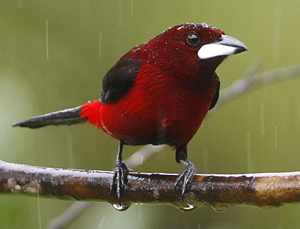 We settled into our rooms and were quickly out exploring the grounds around the lodge. A trail up the hill behind the lodge led to a platform overlooking the sea and we scanned the trees for birds. There were many Magnificent Frigatebirds and Brown Pelicans over the sea and closer to us on the tree tops below were several birds including Cinnamon Becard, Crimson-backed Tanager, Spot-headed Barbet, and Purple-crowned Fairy to name a few. We walked further up stopping on an open deck in front of a cabin. A flock was moving through the trees above and confusion ensued as we tried to identify the birds in the flock including Scarlet-browed Tanager, Rufous-winged Tanager, White-shouldered Tanager, Fulvous-vented Euphonia, Blue-whiskered Tanager, Purple Honeycreeper, Green Manakin, Scarlet-and-White Tanager, Tawny-crested Tanager, and Scarlet-thighed Dacnis. Up at the next overlook, we had a very confiding Pied Puffbird and some Masked Tityras. The sun was setting over the sea as we made our way back down toward the lodge. A Purple-chested Hummingbird was calling from a perch and we scoped it from the veranda. Back at the lodge we enjoyed a delicious home-cooked meal before retiring for the evening.
We settled into our rooms and were quickly out exploring the grounds around the lodge. A trail up the hill behind the lodge led to a platform overlooking the sea and we scanned the trees for birds. There were many Magnificent Frigatebirds and Brown Pelicans over the sea and closer to us on the tree tops below were several birds including Cinnamon Becard, Crimson-backed Tanager, Spot-headed Barbet, and Purple-crowned Fairy to name a few. We walked further up stopping on an open deck in front of a cabin. A flock was moving through the trees above and confusion ensued as we tried to identify the birds in the flock including Scarlet-browed Tanager, Rufous-winged Tanager, White-shouldered Tanager, Fulvous-vented Euphonia, Blue-whiskered Tanager, Purple Honeycreeper, Green Manakin, Scarlet-and-White Tanager, Tawny-crested Tanager, and Scarlet-thighed Dacnis. Up at the next overlook, we had a very confiding Pied Puffbird and some Masked Tityras. The sun was setting over the sea as we made our way back down toward the lodge. A Purple-chested Hummingbird was calling from a perch and we scoped it from the veranda. Back at the lodge we enjoyed a delicious home-cooked meal before retiring for the evening.
22 February :
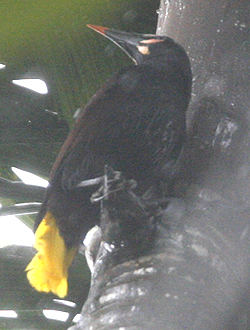 This morning we walked a trail in Utria National Park in the hopes of finding the rare and endemic Baudo Oropendola. The flat, straight trail led through a gorgeous rainforest and overnight rains had created wet, muddy conditions underfoot. As we walked, the rain got heavier requiring us to forge through six inch deep standing water in some areas. We reached a bridge and took a small, side trail into the forest where our guide pointed out a large palm tree with several large sock-like nests hanging from the palm fronds. We repositioned ourselves to see the nests (still raining) and soon we got our first glimpses of Baudo Oropendolas coming in to tend the nests. One bird sat on a frond next to the nests and displayed for several minutes giving a fabulous show. We spent a good amount of time watching the birds, most of us soaked to the bone but enjoying this very rare opportunity. On our way back out the trail we found a few other birds including Purple-throated Fruitcrow, Pacific Antwren, Dusky-faced Tanager,
This morning we walked a trail in Utria National Park in the hopes of finding the rare and endemic Baudo Oropendola. The flat, straight trail led through a gorgeous rainforest and overnight rains had created wet, muddy conditions underfoot. As we walked, the rain got heavier requiring us to forge through six inch deep standing water in some areas. We reached a bridge and took a small, side trail into the forest where our guide pointed out a large palm tree with several large sock-like nests hanging from the palm fronds. We repositioned ourselves to see the nests (still raining) and soon we got our first glimpses of Baudo Oropendolas coming in to tend the nests. One bird sat on a frond next to the nests and displayed for several minutes giving a fabulous show. We spent a good amount of time watching the birds, most of us soaked to the bone but enjoying this very rare opportunity. On our way back out the trail we found a few other birds including Purple-throated Fruitcrow, Pacific Antwren, Dusky-faced Tanager, 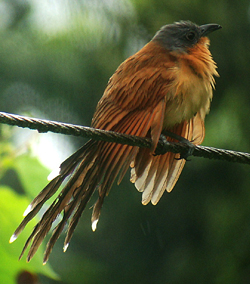 Pied Puffbird, and Black-chested Jay. A wet, bedraggled Gray-capped Cuckoo was spotted perched on a wire and we were thrilled to get such a good view of this rare bird.
Pied Puffbird, and Black-chested Jay. A wet, bedraggled Gray-capped Cuckoo was spotted perched on a wire and we were thrilled to get such a good view of this rare bird.
We went back to the lodge, dried out, and watched the Crimson-backed Tanagers and Red-legged Honeycreepers at the banana feeders. After lunch, we birded along the paved road that we had driven yesterday. It had finally stopped raining and we enjoyed good views of many species along the road including Spot-flanked Gallinule, White-necked Jacobin, Blue-chested Hummingbird, White-tailed Trogon, Scarlet-and-White Tanager, Scarlet-browed Tanager, Cinnamon Woodpecker, the closest views ever of a perched King Vulture, no less than eight Black-tipped Cotingas, Golden-collared Manakin, and two White-thighed Swallows perched on a wire with thighs visible. By the end of the afternoon, the sun was out and we finally felt dry and very pleased with the birds seen throughout the day.
23 February:
This morning we made an early departure to the airport not knowing 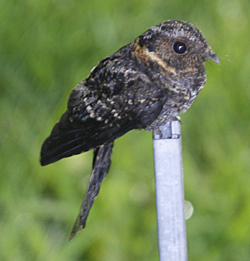 what we might encounter on the bumpy road. We arrived at the airport in plenty of time so did some birding along the road adding Spot-headed Barbet, Rusty-margined Flycatcher, Ringed Kingfisher, and Chestnut-headed Oropendola to our list. We flew to Bogota where we had some time before our flight to Manizales so we visited a park just outside of town to see the endemic Red-bellied Grackle. As we walked the road, we found two White-capped Dippers,a few Slate-throated Redstarts, Emerald Toucanet, and Common Bush Tanager. It wasn’t long before we were watching a pair working some trees on a hillside across the valley from us. The birds flew toward us and up the hill so we ascended in time to have great views of several birds feeding on some fruit trees. This was the finest looking grackle that most of us had seen! On the way back down, we added Russet-backed Oropendola and enjoyed a picnic lunch at the entrance of the reserve during which another small group of Red-bellied Grackles visited. Back at the airport, we waited for our flight to Manizales which was delayed for more than an hour but soon we were off. We arrived at a lovely hotel with thermal pools and checked into our rooms. As it was getting dark, Sergio took us to a water treatment plant and showed us the Lyre-tailed Nightjars that roost, feed, and nest there.
what we might encounter on the bumpy road. We arrived at the airport in plenty of time so did some birding along the road adding Spot-headed Barbet, Rusty-margined Flycatcher, Ringed Kingfisher, and Chestnut-headed Oropendola to our list. We flew to Bogota where we had some time before our flight to Manizales so we visited a park just outside of town to see the endemic Red-bellied Grackle. As we walked the road, we found two White-capped Dippers,a few Slate-throated Redstarts, Emerald Toucanet, and Common Bush Tanager. It wasn’t long before we were watching a pair working some trees on a hillside across the valley from us. The birds flew toward us and up the hill so we ascended in time to have great views of several birds feeding on some fruit trees. This was the finest looking grackle that most of us had seen! On the way back down, we added Russet-backed Oropendola and enjoyed a picnic lunch at the entrance of the reserve during which another small group of Red-bellied Grackles visited. Back at the airport, we waited for our flight to Manizales which was delayed for more than an hour but soon we were off. We arrived at a lovely hotel with thermal pools and checked into our rooms. As it was getting dark, Sergio took us to a water treatment plant and showed us the Lyre-tailed Nightjars that roost, feed, and nest there.
24 February:
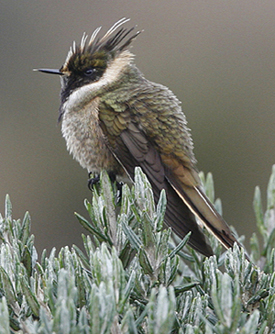 This morning we had early coffee and departed before dawn for Rio Blanco, a reserve on the western slope of the central Andes. The road leading up to the reserved was blocked by landslide so we quickly changed itinerary to visit Los Nevados National Park in the central Colombian Andes to explore the paramo habitat. Our first stop beside a hut that sold much appreciated hats and gloves also yielded Many-striped Canastero, Plumbeous Sierra-Finch, and a few Andean Ducks on a small lake below us. Near the park entrance, we were thrilled to find a confiding Bearded Helmetcrest and showing well several times as it moved among the flowering bushes. Fantastic! The landscape was stunning with snow-covered mountain peaks and sprawling paramo stretching for miles dotted with large, perennial Espeletia plants. Other birds up here included Brown-backed Chat-Tyrant and Tawny Antpitta. We could feel the altitude and were happy to be walking down hill birding along the road and adding Andean Tit-Spinetail, Black-backed Bush Tanager, Blue-backed Conebill, Scarlet-bellied Mountain Tanager, Glossy Flowerpiercer, Golden-fronted Redstart, Viridian Metaltail, Golden-breasted Puffleg, Black-chested Buzzard Eagle, White-chinned Thistletail, and Stout-billed Cinclodes.
This morning we had early coffee and departed before dawn for Rio Blanco, a reserve on the western slope of the central Andes. The road leading up to the reserved was blocked by landslide so we quickly changed itinerary to visit Los Nevados National Park in the central Colombian Andes to explore the paramo habitat. Our first stop beside a hut that sold much appreciated hats and gloves also yielded Many-striped Canastero, Plumbeous Sierra-Finch, and a few Andean Ducks on a small lake below us. Near the park entrance, we were thrilled to find a confiding Bearded Helmetcrest and showing well several times as it moved among the flowering bushes. Fantastic! The landscape was stunning with snow-covered mountain peaks and sprawling paramo stretching for miles dotted with large, perennial Espeletia plants. Other birds up here included Brown-backed Chat-Tyrant and Tawny Antpitta. We could feel the altitude and were happy to be walking down hill birding along the road and adding Andean Tit-Spinetail, Black-backed Bush Tanager, Blue-backed Conebill, Scarlet-bellied Mountain Tanager, Glossy Flowerpiercer, Golden-fronted Redstart, Viridian Metaltail, Golden-breasted Puffleg, Black-chested Buzzard Eagle, White-chinned Thistletail, and Stout-billed Cinclodes.
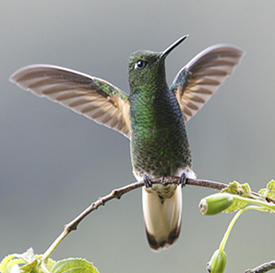 By late morning, Sergio received a call that the road up to Rio Blanco was open so we made our way up there for lunch. As we approached the lodge building we could see hummingbirds buzzing around in every direction. The most common species was Buff-tailed Coronet. Other species seen included Fawn-breasted Brilliant, Sparkling Violetear, White-bellied Woodstar, Speckled Hummingbird, Long-tailed Sylph, Collared Inca, Bronzy Inca, and Tourmaline Sunangel. Cameras clicked away at the antics of the hummingbirds and gasps of delight, “Que lindo, que lindo!” from Juliana revealed that she was dangerously close to becoming a birder! At 4 PM, we dutifully followed the “Worm Man” up to an area where he had been feeding worms to Antpittas, a practice started some years ago in Ecuador to allow easier viewing of these elusive birds. On the way up we were delayed by a large flock that kept us busy for several minutes with Ruddy Treerunner, Golden-fronted Restart, Montane Woodcreeper, Olive-sided Flycatcher, White-tailed Elaenia, Barred Becard, Ruddy Treerunner, Cinnamon Flycatcher, Capped Conebill, Brown-capped Vireo, and Superciliaried Hemispingus. Phew! The Worm Man patiently waited for us to follow him up the hill and we took a side trail to an area with a bench and rain cover and made ourselves comfortable. He placed the worms into a sunken bowl, moved away
By late morning, Sergio received a call that the road up to Rio Blanco was open so we made our way up there for lunch. As we approached the lodge building we could see hummingbirds buzzing around in every direction. The most common species was Buff-tailed Coronet. Other species seen included Fawn-breasted Brilliant, Sparkling Violetear, White-bellied Woodstar, Speckled Hummingbird, Long-tailed Sylph, Collared Inca, Bronzy Inca, and Tourmaline Sunangel. Cameras clicked away at the antics of the hummingbirds and gasps of delight, “Que lindo, que lindo!” from Juliana revealed that she was dangerously close to becoming a birder! At 4 PM, we dutifully followed the “Worm Man” up to an area where he had been feeding worms to Antpittas, a practice started some years ago in Ecuador to allow easier viewing of these elusive birds. On the way up we were delayed by a large flock that kept us busy for several minutes with Ruddy Treerunner, Golden-fronted Restart, Montane Woodcreeper, Olive-sided Flycatcher, White-tailed Elaenia, Barred Becard, Ruddy Treerunner, Cinnamon Flycatcher, Capped Conebill, Brown-capped Vireo, and Superciliaried Hemispingus. Phew! The Worm Man patiently waited for us to follow him up the hill and we took a side trail to an area with a bench and rain cover and made ourselves comfortable. He placed the worms into a sunken bowl, moved away 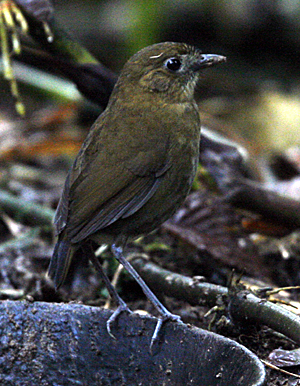 and started whistling and soon three species of Antpitta came in for dinner. Chestnut–crowned Antpitta was first, followed by a quick visit by Slate-capped Antpitta, and several visits by the endemic Brown-banded Antpitta. It was an excellent show and a unique chance to view these species. After an hour or so, we headed back down to the lodge adding Stripe-headed Brush Finch on the way. There was still much activity at the feeders as the sun set in the background marking the end of another great day!
and started whistling and soon three species of Antpitta came in for dinner. Chestnut–crowned Antpitta was first, followed by a quick visit by Slate-capped Antpitta, and several visits by the endemic Brown-banded Antpitta. It was an excellent show and a unique chance to view these species. After an hour or so, we headed back down to the lodge adding Stripe-headed Brush Finch on the way. There was still much activity at the feeders as the sun set in the background marking the end of another great day!
25 February:
In the morning, we went back to Rio Blanco reserve for breakfast and then walked the trails above the lodge. The forest seemed quiet at first but soon we were watching many birds including Black-collared Jay, Pearled Treerunner, and Crimson-mantled Woodpecker. A Dusky Piha flew in and perched above us and we were pleased with great views of the bird. Other birds seen were Tawny-breasted Hermit, Mountain Wren, Rufous-crowned Tody Tyrant, Gray-hooded Bush Tanager, Plushcaps, Lacrimose Mountain Tanager, Capped Conebill, Blue-and-black Tanagers, Blue-capped Tanager, Grass-green Tanagers, and a Masked Trogon perched on a branch just above the trail. A Flammulated Treehunter was seen in the same area and we soon realized that it was bringing food into a tangle and we could hear the young birds calling as the adult arrived. On the way back we had Black-billed Mountain Toucan, Rufous-capped Flycatcher, and Pale-edged Flycatcher. Chestnut-crowned Antpittas were calling all around us and a Bicolored Antpitta called and came close but did not show.
After lunch, we flew back to Bogota arriving in a rain/hail storm and then drove to Chicaque National Park in the cloud forest hills above the nation’s capital. We arrived at the Spanish style log lodge and went immediately to the deck to enjoy the view as the sunset. Later on, we met for dinner and a review of our checklist what was growing ever longer.
26 February:
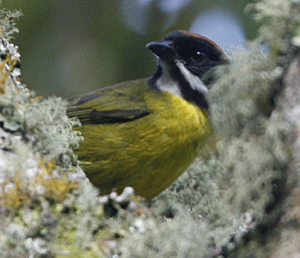 This morning we explored the trails of Chicaque National Park. Our morning walk up a hill yielded Metallic-green Tanager, Blue-and-black Tanager, Beryl-spangled Tanager, Black-capped Tanager, Montane Foliage Gleaner, Rufous-breasted Flycatcher, Golden-crowned Flycatcher, Uniform Antshrike, a noisy flock of Moustached Brush-finches, Smoky-brown Woodpecker, Brown-capped Vireo, Streaked Xenops, Montane Woodcreeper, White-tailed Tyrannulet, Russet-crowned Warbler, Ash-browed Spinetail, Striped Woodcreeper, and Ashy-throated Bush Tanager. Needless to say, the birding was amazing and we went back to the lodge for a mid-morning snack to replenish our energy. While sitting at the picnic tables, we spotted a lovely Flame-faced Tanager and Blue-necked Tanager that was working some flowers just on the edge of the forest. After a break, we walked the trails of a primeval forest with towering oaks and eucalyptus trees. We added Black-eared Hemispingus, Golden Tanager, Green-and-Black Fruiteater, and the endemic Black Inca perched on a low branch. At the end of the trail there was some woodpecker activity and we had good views of both Crimson-mantled and Acorn Woodpeckers. After lunch, we traveled back to Bogota for the night enjoying a nice meal in one of the city restaurants.
This morning we explored the trails of Chicaque National Park. Our morning walk up a hill yielded Metallic-green Tanager, Blue-and-black Tanager, Beryl-spangled Tanager, Black-capped Tanager, Montane Foliage Gleaner, Rufous-breasted Flycatcher, Golden-crowned Flycatcher, Uniform Antshrike, a noisy flock of Moustached Brush-finches, Smoky-brown Woodpecker, Brown-capped Vireo, Streaked Xenops, Montane Woodcreeper, White-tailed Tyrannulet, Russet-crowned Warbler, Ash-browed Spinetail, Striped Woodcreeper, and Ashy-throated Bush Tanager. Needless to say, the birding was amazing and we went back to the lodge for a mid-morning snack to replenish our energy. While sitting at the picnic tables, we spotted a lovely Flame-faced Tanager and Blue-necked Tanager that was working some flowers just on the edge of the forest. After a break, we walked the trails of a primeval forest with towering oaks and eucalyptus trees. We added Black-eared Hemispingus, Golden Tanager, Green-and-Black Fruiteater, and the endemic Black Inca perched on a low branch. At the end of the trail there was some woodpecker activity and we had good views of both Crimson-mantled and Acorn Woodpeckers. After lunch, we traveled back to Bogota for the night enjoying a nice meal in one of the city restaurants.
27 February:
Today we spent at the convention center in Bogota to participate in Destination Colombia 2009 – a trade show highlighting tourism possibilities in the country. After a ceremony to launch the new www.colombia.travel web site and we met with businesses and lodges from around the country to discuss tour possibilities and logistics. In the evening we attended the closing ceremonies complete with native music and dancing.
28 February:
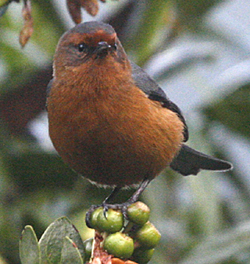 We had some time before our departure flight this morning so we took advantage of our last few hours in Colombia to bird some areas around Bogota. We birded along the road leading to one of the monuments above the city. There were a few Tawny-breasted Tinamous calling and as we enjoyed our field breakfast we got good views of a perched Glowing Puffleg. As we walked up the road, we added several birds to our Colombia list including White-naped Brush Finch, Coppery-bellied Puffleg, Superciliaried Hemispingus, Black-capped Hemispingus, Plushcaps, Scarlet-breasted Mountain Tanager, Rufous-browed Conebill, White-throated Tyrannulet, Black-crested Warbler, Red-crested Cotinga, Slaty Brush-finch, Silvery-throated Spinetail,and Agile Tit-tyrant. From here we visited Parque Florida near the international airport where we found Spot-flanked Gallinule, some interesting looking American Coots, some close Brown-bellied Swallows, and several Yellow-hooded Blackbirds. We spent a bit of time trying to see Bogota Rail and there were at least four calling but all stayed hidden in the reeds. Just as we were beginning to board the bus, we were called back to see the bird walking on some Water Hyacinths. The bird disappeared before we got there but another one flew off right in front of us allowing great views! Bogota Rail! What a way to end the trip!
We had some time before our departure flight this morning so we took advantage of our last few hours in Colombia to bird some areas around Bogota. We birded along the road leading to one of the monuments above the city. There were a few Tawny-breasted Tinamous calling and as we enjoyed our field breakfast we got good views of a perched Glowing Puffleg. As we walked up the road, we added several birds to our Colombia list including White-naped Brush Finch, Coppery-bellied Puffleg, Superciliaried Hemispingus, Black-capped Hemispingus, Plushcaps, Scarlet-breasted Mountain Tanager, Rufous-browed Conebill, White-throated Tyrannulet, Black-crested Warbler, Red-crested Cotinga, Slaty Brush-finch, Silvery-throated Spinetail,and Agile Tit-tyrant. From here we visited Parque Florida near the international airport where we found Spot-flanked Gallinule, some interesting looking American Coots, some close Brown-bellied Swallows, and several Yellow-hooded Blackbirds. We spent a bit of time trying to see Bogota Rail and there were at least four calling but all stayed hidden in the reeds. Just as we were beginning to board the bus, we were called back to see the bird walking on some Water Hyacinths. The bird disappeared before we got there but another one flew off right in front of us allowing great views! Bogota Rail! What a way to end the trip!
At the airport, we said goodbye to our colleagues and thanked Juliana for all of her efforts to make the trip a success. From first hand experience, I can say that the areas we visited were safe and Colombians are friendly people, proud of their country, and pleased to share it with visitors. The bird watching in Colombia is unsurpassed. 2009 is the third year that birding tours have visited Colombia and the logistics are being improved with each itinerary. Watch for a Sunrise Birding, LLC tour to this incredible country!
Colombian Rainforest
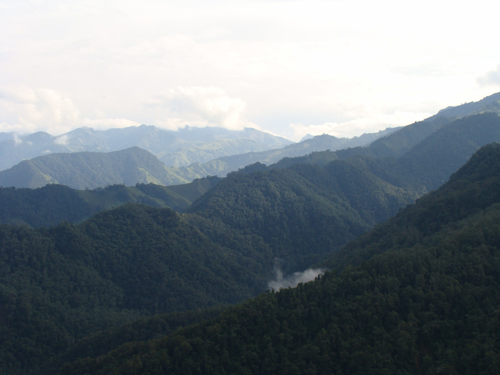
Paramo habitat at Los Nevados National Park
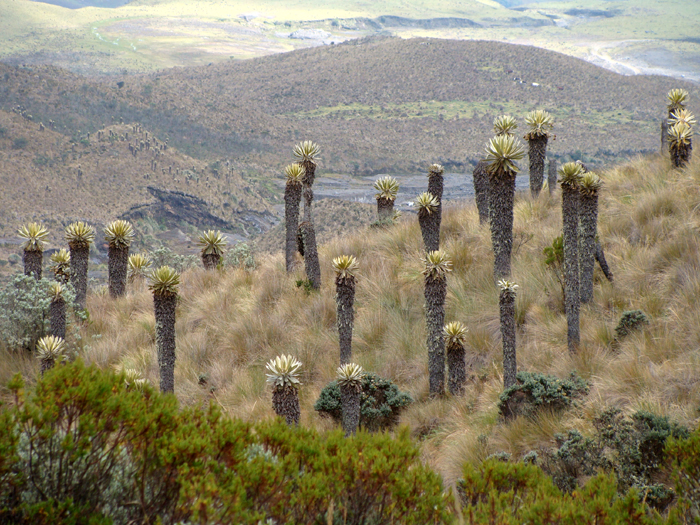
Central Pacific Coast, Colombia
La Chiva, typical Colombian transport
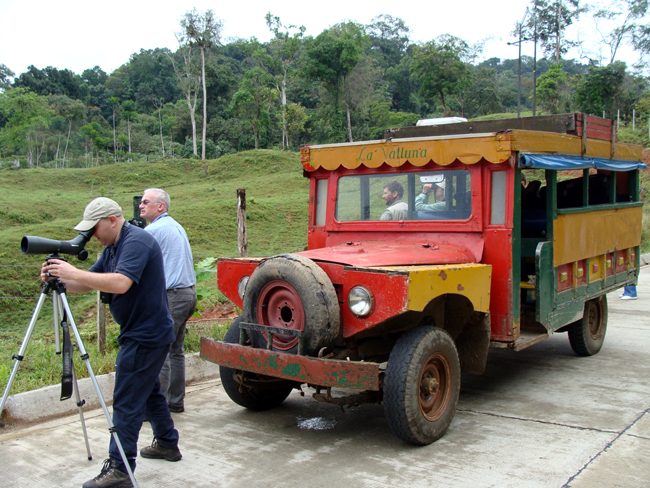
Birders at Los Nevados National Park, Colombia
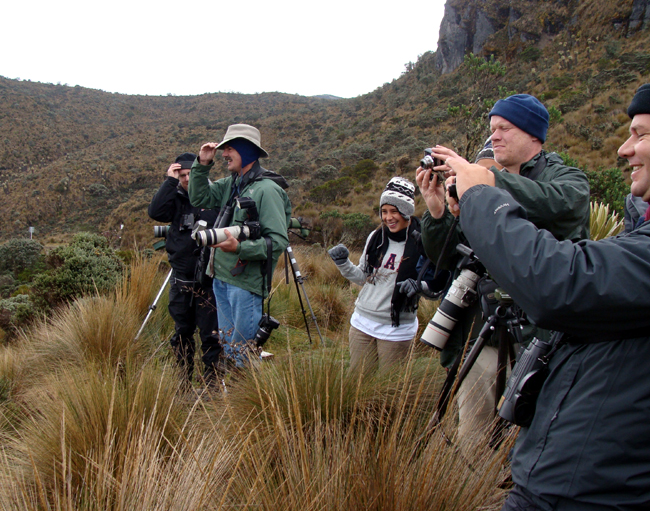
For more information, contact Gina Nichol at 203.453.6724 or [email protected]